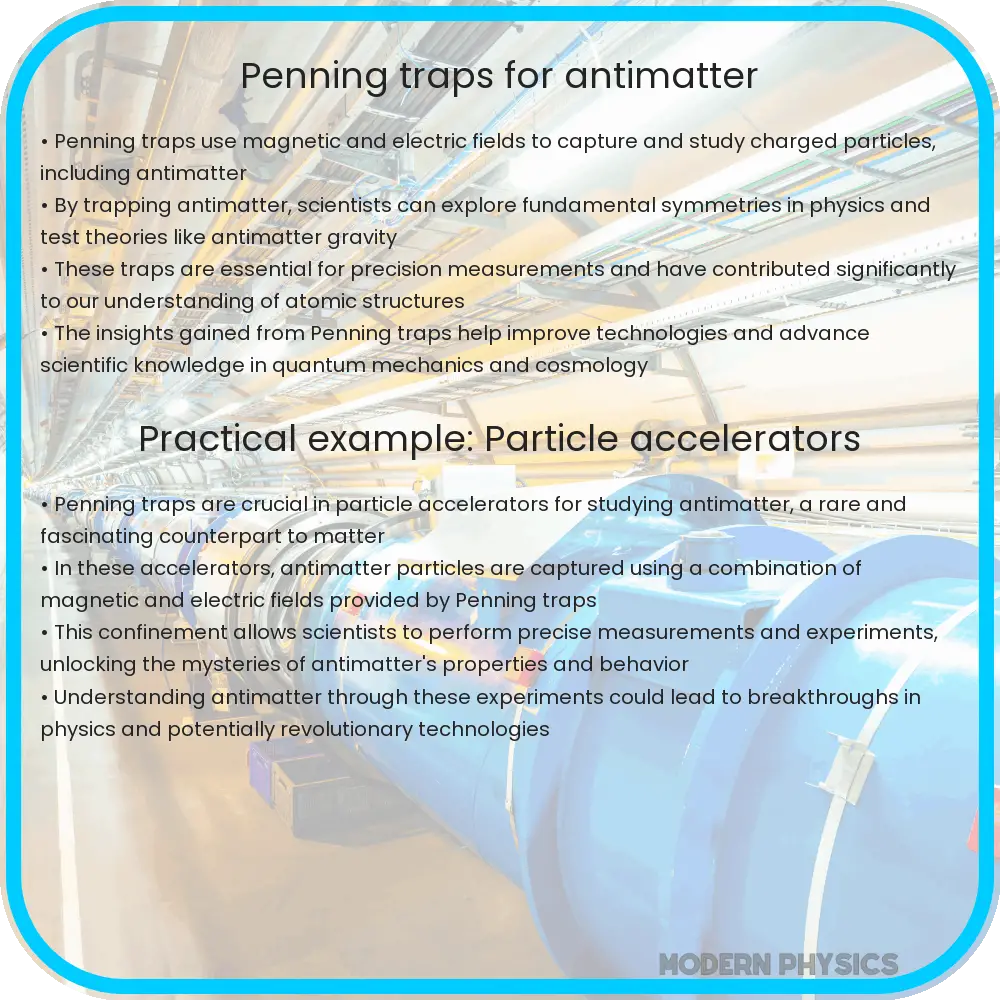Learn about the Penning Trap, a device that uses electric and magnetic fields to trap charged particles for scientific research.

Understanding Penning Traps: Capturing Antimatter Basics
Antimatter, often discussed in the realms of science fiction, is as real as the matter that makes up our everyday world. However, studying antimatter presents unique challenges, primarily how to contain it without it annihilating upon contact with matter. One of the fundamental tools for capturing and studying antimatter is the Penning Trap. This device not only traps antimatter particles but also ions and electrons for high precision measurements.
What is a Penning Trap?
A Penning Trap is an apparatus that uses electric and magnetic fields to store charged particles. Named after Frans Michel Penning, a Dutch physicist who contributed foundational work to the technology, it is indispensable in the fields of quantum mechanics, gaseous ion chemistry, and fundamental particle physics. The device leverages the principles of electromagnetism to balance forces on a charged particle, effectively holding it in place.
Components of a Penning Trap
The core components of any Penning Trap include:
- Electrodes: Generally, two endcap electrodes and a ring electrode. These create a stable electric field that confines the charged particles axially.
- Magnet: A strong, homogeneous magnetic field is applied perpendicular to the electric field, which confines the particles radially.
How Does a Penning Trap Work?
The physics behind a Penning Trap is intricate, relying on both electric and magnetic fields. The key lies in balancing these fields to create a potential well for charged particles. Here’s a simplified breakdown:
- The electric field is generated by applying a voltage between the ring and the endcap electrodes. This field has a quadratic potential in the axial direction, pushing the charged particle towards the center.
- The magnetic field is orthogonal to the electric field and forces the particle to move in a circular path due to the Lorentz force, which acts perpendicular to the velocity of the particle and the magnetic field.
The result of these perpendicular fields is a three-dimensional trapping of the particle where it oscillates along the axis of the trap and rotates around it, technically described as a combination of axial and cyclotron motions.
Mathematical Model of Motion in a Penning Trap
The motion of a charged particle in a Penning Trap is a classic example of motion under conservative forces. It combines harmonic motion along the axis of the trap with a circular motion in the plane perpendicular to it. The generalized equation for the motion of a particle can be represented as:
z(t) = z0 cos(ωzt + φz)
r(t) = r0 cos(ωrt + φr)
Where z(t) represents axial motion, r(t) represents radial motion, ωz and ωr are the angular frequencies of axial and radial motions, and φz and φr are the respective phase constants. This simple model provides insights into the stability and behavior of the trapped particle.
Understanding these motions is crucial for experimenting with and measuring the properties of the captured particles, such as their mass, charge, magnetic moments, and other quantum characteristics.
Applications of Penning Traps
The practical uses of Penning Traps extend beyond fundamental physics research to encompass mass spectrometry, precise clock synchronization technologies, and even quantum computing. The ability to accurately control and measure minute particles and their properties enables advancements across multiple scientific disciplines.
In the next section, we shall explore more about how Penning Traps are used in research activities, especially focusing on antimatter confinement and measurement techniques.
Research and Experiments with Penning Traps
Penning Traps have become vital in experimental physics, particularly in the study of antimatter. The ability to trap antimatter atoms allows physicists to compare them with their matter counterparts. This comparison is essential in testing the symmetry of nature and understanding why the observable universe is predominantly composed of matter, despite theories suggesting equal amounts of matter and antimatter should have been created during the Big Bang.
- Antimatter Confinement: Antimatter particles, such as positrons or antiprotons, are trapped to prevent them from coming into contact with matter, where they would annihilate. By holding these particles stationary, researchers can observe their interactions and decay over time, providing valuable insights into the fundamental asymmetries between matter and antimatter.
- Precision Measurements: The stable environment of a Penning Trap allows for ultra-precise measurements of particle properties like mass and magnetic moments. These measurements are crucial for testing the predictions of theoretical physics and enhancing the standard model of particle physics.
Future of Penning Traps
The versatility and precision of Penning Traps hold promise for new technological applications. As we develop better control over quantum systems, the role of Penning Traps in quantum computing and information processing continues to grow. Researchers are also exploring the potential of these traps in more advanced forms of mass spectrometry and high-accuracy time-keeping systems, which could revolutionize various scientific and commercial fields.
Moreover, ongoing advancements in Penning Trap technology could further our understanding of the universe’s most elusive components, potentially leading to breakthroughs in energy, material science, and theoretical physics.
Conclusion
The Penning Trap exemplifies how sophisticated engineering combined with fundamental physics principles can lead to profound scientific advancements. From capturing antimatter and isolating exotic particles to refining the measurements that underpin our understanding of the universe, these devices offer a window into the intricacies of the quantum world. As research continues, the applications of Penning Traps are bound to expand, driving further innovation and perhaps even transforming our approach to science and technology. Ultimately, these devices not only help us tackle some of the most perplexing questions of physics but also underscore the enduring significance of curiosity and precision in scientific inquiry.
